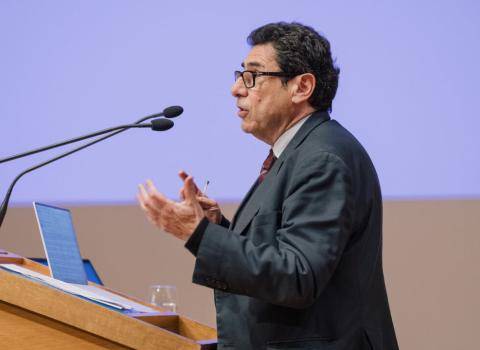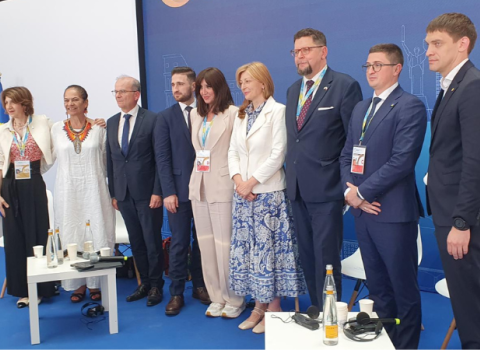
Just twelve short months ago, the mid-term review of the European Union’s R&D flagship, Framework Programme Six (FP6), was seen as a unique opportunity to lobby for an increase in the €54 billion budget for science and technology research. The scale of the impending global financial crisis was unknown at the time.
One year on that opportunity has been extinguished by the sudden and dramatic unravelling of the world’s financial system and the sharp decline into recession of some of Europe’s largest economies.
At a recent seminar in Brussels hosted by Science|Business, two brave senior European Commission officials involved in FP7 defended the programme amid specific criticisms – and concrete suggestions for how to make it work better – from a room full of corporate executives, university directors and research group representatives.
The optimism of last January has dissipated somewhat. “There’s not much chance of a generous budget increase now,” said Clara de la Torre, Director for the Framework Programme in DG Research.
de la Torre and Waldemar Kütt, deputy chef de cabinet for Science and Research Commissioner Janez Potočnik, were asked by several of the seminar participants why the procedure for handing out FP7 funds is so complicated and bureaucratic.
“You have to find a balance between accountability and ease of use,” said Kalliopi Spyridaki, EU public policy manager for the business intelligence software company SAS. “Businesses new to the world of EU research funding and small firms will be put at a distinct disadvantage by the complexity of the questionnaires.”
Lianne Pelmi, European external funding finance manager at Procter & Gamble gave a practical suggestion to make life easier: simplify the guidelines for FP7 applicants. Evaluation scores from the officials handling applications are low if you don’t interpret the complex guidelines correctly, she said.
De la Torre made a note of Pelmi’s suggestion regarding the guidelines. More broadly, she explained that the European Parliament demands that the Commission accounts for everything when it comes to distributing EU research funds. Kütt acknowledged the complexity of the application paperwork and said that Commissioner Potočnik has committed to simplifying the Framework Programme wherever possible.
JTI overheads row simmers on
The capping of overhead costs as a proportion of grants handed out under the Joint Technology Initiatives (JTIs) sparked fear and loathing in roughly equal measure. Fear that the 20 per cent rule might be introduced to all FP7 programmes, and loathing, because researchers argue that as overheads often amount to 60 per cent of costs, most of them have to be paid for by the researcher or university, with no help from FP7.
“Will it result in all FP7 projects having a 20 per cent cap?” asked Mikael Kekkonen, project executive at the European Association of Research and Technology Organizations (EARTO).
“Our members are not criticising JTIs as such, just this 20 per cent rule. We hope it doesn’t eventually work its way into FP7,” he added.
Kütt assured Kekkonen this isn’t being planned and explained why it had been introduced for the JTIs. As well as trying to encourage research organisations to apply full cost accounting methods, he said, “The 20 per cent cap in JTIs is because we want more research for our bucks. We understand it created difficulties with some organisations. There are ways to fix this,” he said.
The row over JTIs, the European Union’s main programmes for industry/academic collaboration, first erupted in November 2008, with representatives of Europe’s universities and research and technology organisations claiming researchers would be put off applying if the European Union only funded 20 per cent of overhead costs.
The 20 per cent cap fell far short of what was promised in the EU's research strategy for FP7, claimed the Deputy Secretary General of the European University Association, Dr John Smith, who said the rules of participation outlined in FP7 state that EU funds should
cover 75 percent of direct costs of research and 60 percent of indirect costs or overheads, and questioned why these rules were not being applied to the JTIs
EARTO joined the debate, saying, “Such unrealistic capping of overhead costs displays grave ignorance of the economic realities of research.”
Full cost accounting
Michael Browne, Head of European R&D at University College London, asked if there was any news in relation to the flat indirect cost rate, which is due to be adjusted for the start of 2010. He also asked the Commission “to take into consideration the fact that many universities throughout Europe are still not able to demonstrate Full Economic Costing, which means that a significant reduction in the current flat rate would be detrimental to the participation level and overall implementation of the Framework Programme.”
“We are getting contrasting messages,” said de la Torre. “The European Parliament feels strongly that we need to encourage universities to move towards full cost accounting. On the other hand we know that it is harder to do that in some countries than in others.”
Why aren’t JTIs more open? asked André Hagehülsmann, innovation manager for Europe at Microsoft. “We would appreciate more flexibility for organisations wanting to participate in FP7. FP7 should be more adaptive and reactive, and hence more agile and flexible,” he said.
Kütt agreed that JTIs are public–private partnerships and that the private side may take into account strategic considerations in building its side of the partnership. But the public contribution to a JTI is generally used for paying projects selected through a fully open call.
Why does private industry wield so much power in the JTIs? asked Joanna Mastalerek, finance manager at the European Liaison office of the German research organisations (KOWI). “For example, the governing board of the Hydrogen and Fuel Cell JTI has just one research body member for six from industry,” she pointed out
“There’s private money involved; when industry is paying half the bill you can’t expect to have the same EC rules as in usual collaborative contracts,” Kütt said in reply.
The Commission received praise as well as criticism, especially for the way FP7 is designed to encourage cooperation with research bodies outside the EU.
Daan Du Toit, senior science and technology representative at the South African mission to the EU, praised the fact that FP7 allows collaboration beyond the EU’s borders. “It’s a unique instrument for internationalising research, especially in the field of life sciences,” he said.
Another international representative echoed this praise, saying that many SMEs in her country are eager to get involved in FP7.




 A unique international forum for public research organisations and companies to connect their external engagement with strategic interests around their R&D system.
A unique international forum for public research organisations and companies to connect their external engagement with strategic interests around their R&D system.